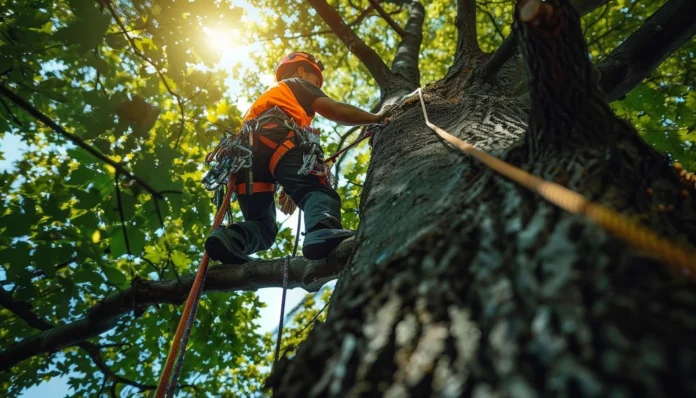Trees play a crucial role in our environment by improving air quality, providing shade, and enhancing landscapes. Regular maintenance, especially pruning, is vital for their health and safety. This article discusses the significance of tree pruning, the role of arborists, effective techniques, the benefits of routine pruning, and tips for selecting the right arborist for these services.
The Importance of Tree Pruning
Tree pruning is more than just trimming branches; it’s a critical practice for maintaining the health, safety, and aesthetics of trees. Proper pruning can:
- Prevent Disease: Removing diseased or damaged branches helps prevent the spread of pathogens and pests.
- Enhance Growth: Strategic pruning encourages healthy growth patterns and improves the overall structure of the tree.
- Increase Safety: Eliminating weak or dead branches reduces the risk of falling limbs, protecting property and people.
- Improve Aesthetics: Pruning shapes the tree, enhancing its natural beauty and contributing to a well-maintained landscape.
The Role of Arborists in Maintaining Tree Health
Arborists are tree care professionals with specialized training in the biology, growth, and maintenance of trees. Their expertise is crucial for effective pruning and overall tree care. Arborists play several roles in promoting tree wellness:
- Assessment and Diagnosis: Arborists assess the health and structure of trees, identifying any issues such as disease, pest infestations, or structural weaknesses.
- Customized Care Plans: Based on their assessment, arborists develop customized care plans that include pruning schedules and techniques tailored to the specific needs of each tree.
- Safe and Effective Pruning: Arborists use their knowledge and skills to perform pruning safely and effectively, ensuring the long-term health and stability of the tree.
- Education and Recommendations: Arborists educate tree owners about proper tree care practices and recommend additional treatments or interventions as needed.
Techniques Used by Arborists for Effective Pruning
Arborists employ a variety of pruning techniques to ensure optimal tree health and growth. Some of the most common techniques include:
- Crown Thinning: This technique involves selectively removing branches from the tree’s crown to increase light penetration and air circulation. It helps reduce the risk of disease and promotes healthy growth.
- Crown Raising: Crown raising involves removing lower branches to provide clearance for pedestrians, vehicles, or structures. It improves safety and accessibility without compromising the tree’s health.
- Crown Reduction: This method reduces the overall size of the tree’s crown, typically to prevent interference with power lines or structures. It helps maintain the tree’s natural shape and stability.
- Deadwooding: Removing dead or dying branches is crucial for preventing the spread of disease and reducing the risk of falling limbs; tree removal services like those available in Salt Lake City can help with this maintenance.
- Structural Pruning: This technique focuses on improving the tree’s structural integrity by removing weak or competing branches, promoting a strong and stable framework.
Benefits of Regular Pruning for Trees
Regular pruning offers numerous benefits that contribute to the overall health and longevity of trees:
- Enhanced Health: Pruning removes diseased, damaged, or dead branches, preventing the spread of pathogens and promoting healthy growth.
- Improved Safety: By eliminating weak or hazardous branches, pruning reduces the risk of property damage and personal injury.
- Increased Sunlight and Airflow: Thinning the tree’s canopy allows more sunlight and air to reach the interior branches, reducing the risk of fungal infections and improving overall tree health.
- Stronger Structure: Structural pruning encourages strong branch connections and a stable framework, reducing the likelihood of storm damage.
- Aesthetic Appeal: Regular pruning maintains the tree’s shape and appearance, enhancing the beauty of your landscape.
Tips for Choosing the Right Arborist for Pruning Services
Selecting a qualified arborist is essential for ensuring the health and safety of your trees. Here are some tips for choosing the right arborist for pruning services:
- Check Certifications: Look for arborists certified by reputable organizations such as the International Society of Arboriculture (ISA). Certification indicates a high level of knowledge and professionalism.
- Verify Insurance: Ensure the arborist carries liability and workers’ compensation insurance to protect against potential accidents or damage.
- Ask for References: Request references from previous clients to gauge the arborist’s track record and customer satisfaction.
- Request a Detailed Estimate: Obtain a written estimate that outlines the scope of work, costs, and timeline. Compare estimates from multiple arborists to make an informed decision.
- Evaluate Experience and Equipment: Choose an arborist with experience in pruning the specific types of trees on your property and who uses proper equipment for safe and efficient pruning.
Conclusion
Tree pruning is a vital practice for maintaining the health, safety, and beauty of trees. Arborists play a crucial role in performing effective pruning and ensuring the long-term wellness of trees. By understanding the importance of pruning, recognizing the benefits, and selecting a qualified arborist, you can promote healthy and thriving trees that enhance your landscape for years to come.

